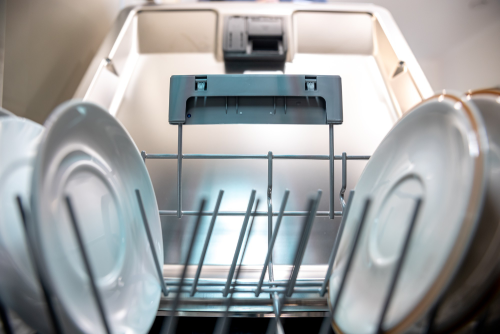Low temperature commercial dishwashers have wash and rinse cycles that run between 120 and 150 degrees Fahrenheit (°F). This temperature range does not achieve sanitation alone so the low-temp dish machines require chemical sanitizers. Although you are utilizing chemicals for sanitation, the water temperature has a large effect on cleaning results. Here are several things you need to know about your low-temp dish machine:
- The Right Temperature: The quick answer is between 140 °F and 150 °F.
- The Source of the Hot Water: Low-temp dishwasher machines do not heat the water, they use the water from your hot water heater. In order to get the correct water temperature in the dish machine, you’ll need to adjust the temperature on the water heater.
- National Sanitary Foundation Requirements: For low-temp dish machines the National Sanitary Foundation (NSF) requires a minimum of 120 °F for automatic dishwasher machine applications. Therefore, this is the bare minimum and a temperature less than 120 °F will result in a health department violation. Local codes may be higher but none will be lower. Check your local codes to ensure you’re following the correct guidelines.
- 120 °F Leads to Bad Results: While 120 °F is the bare minimum, 120 °F will leave you with poor cleaning results for a number of reasons.
- If the dish machine water temperature is lower than 138.5 °F (the temperature that animal fat begins to break down), the dish machine is depending upon the detergent to do all of the work to remove the fat. This is not practical or cost effective and the residual grease and fat will cause film on the wares, spotting on the glassware and smears on the flatware.
- Grease will build up inside the dish machine and there will be a visible film on the walls. Also, the water from every rack of dishes will be mixing with this residual grease and some of that will redeposit onto the dishes.
- Dishes will dry slowly which then slows down the operation. Dishes may be stacked before they are dry but then the water will accumulate on the stacked dishes leading to water rings on the wears.
- The Purpose of the Drying Agent: The Drying Agent is designed to disperse within a certain temperature range, which is referred to as the cloud point. At the prescribed temperature, the drying agent disperses, which temporarily turns the water cloudy. Once dispersed, the drying agent gives the rinse water a sheeting effect allowing the water to run off quickly so the wares dry faster. It’s important to make sure you utilize a high quality drying agent along with setting the dish machine at the proper temperature to achieve the best results.
- The Indication of the Wrong Temperature: Every dish machine has a temperature gauge installed on it, however, it’s important to also pay attention to the presence of suds in the rinse water, as this is an indication that the water is not hot enough. The rinse additive in combination with the residual animal fat make a soap and leave a film on the dishes. To counteract this situation, you can either raise the water temperature or reduce the amount of drying agent. Raising the water temperature is the best option because if you reduce the drying agent it will leave the wares wetter and result in a greasier film.


